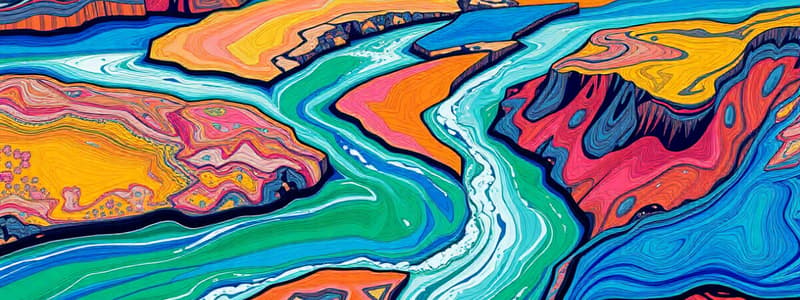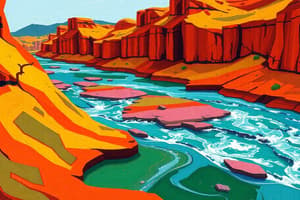Podcast
Questions and Answers
Which of the following best describes a tributary?
Which of the following best describes a tributary?
- A raised bank built to prevent flooding.
- A smaller stream that joins a larger river. (correct)
- The end point of a river where it meets the sea.
- A large bend in the river's course.
A confluence is where a river ends its journey into a larger body of water.
A confluence is where a river ends its journey into a larger body of water.
False (B)
Define a drainage basin in the context of a river system.
Define a drainage basin in the context of a river system.
An area of land where precipitation collects and drains into a river.
The process by which a river wears away the land and rocks is known as ______.
The process by which a river wears away the land and rocks is known as ______.
Match each term to its correct description:
Match each term to its correct description:
Which river feature is typically found in the middle course of a river?
Which river feature is typically found in the middle course of a river?
An ox-bow lake is formed when a river overflows its banks during a flood.
An ox-bow lake is formed when a river overflows its banks during a flood.
Describe how a waterfall is formed in the upper course of a river.
Describe how a waterfall is formed in the upper course of a river.
The flat area around a river that is prone to flooding is known as the ______.
The flat area around a river that is prone to flooding is known as the ______.
Match each term with its function in managing flood risks:
Match each term with its function in managing flood risks:
What process describes water soaking into the ground from the surface?
What process describes water soaking into the ground from the surface?
Surface runoff occurs when water evaporates from the land before it can infiltrate.
Surface runoff occurs when water evaporates from the land before it can infiltrate.
Briefly describe the four main components of the water cycle.
Briefly describe the four main components of the water cycle.
River flooding can occur when a river's capacity is exceeded due to heavy rainfall or rapid ______.
River flooding can occur when a river's capacity is exceeded due to heavy rainfall or rapid ______.
Match each characteristic to the course of the river where it is typically found:
Match each characteristic to the course of the river where it is typically found:
Which of these is a method of preventing river flooding?
Which of these is a method of preventing river flooding?
The source of a river is typically located at the mouth, where it empties into a large body of water.
The source of a river is typically located at the mouth, where it empties into a large body of water.
Explain the difference between the upper and lower courses of a river in terms of water flow and land features.
Explain the difference between the upper and lower courses of a river in terms of water flow and land features.
A raised bank along a river, which can be natural or man-made, to prevent flooding is called a ______.
A raised bank along a river, which can be natural or man-made, to prevent flooding is called a ______.
Match the flooding cause with its effect
Match the flooding cause with its effect
Flashcards
What is a river's source?
What is a river's source?
The starting point of a river, often located in hilly or mountainous areas.
What is a river's mouth?
What is a river's mouth?
The place where a river flows and ends, typically into a sea or ocean.
What is a river tributary?
What is a river tributary?
A smaller stream or river that joins and flows into a larger river.
What is a confluence?
What is a confluence?
Signup and view all the flashcards
What is a drainage basin?
What is a drainage basin?
Signup and view all the flashcards
What is river erosion?
What is river erosion?
Signup and view all the flashcards
What is river transportation?
What is river transportation?
Signup and view all the flashcards
What is river deposition?
What is river deposition?
Signup and view all the flashcards
What is a meander?
What is a meander?
Signup and view all the flashcards
What is an ox-bow lake?
What is an ox-bow lake?
Signup and view all the flashcards
What is a waterfall?
What is a waterfall?
Signup and view all the flashcards
What is a floodplain?
What is a floodplain?
Signup and view all the flashcards
What is a levee?
What is a levee?
Signup and view all the flashcards
What is infiltration?
What is infiltration?
Signup and view all the flashcards
What is surface runoff?
What is surface runoff?
Signup and view all the flashcards
What is the water cycle?
What is the water cycle?
Signup and view all the flashcards
What causes river flooding?
What causes river flooding?
Signup and view all the flashcards
How to prevent flooding?
How to prevent flooding?
Signup and view all the flashcards
What is the upper course of a river like?
What is the upper course of a river like?
Signup and view all the flashcards
What is the lower course of a river like?
What is the lower course of a river like?
Signup and view all the flashcards
Study Notes
- The source of a river is its origin, typically located in hills or mountains.
- The mouth of a river is where it ends, flowing into a sea or ocean.
- A tributary is a smaller stream or river that joins a larger river.
- A confluence is the point where two rivers or streams meet.
- A drainage basin is the area of land from which precipitation flows into a river.
- Erosion in rivers is the process of the river wearing away the land and rocks.
- Transportation in rivers refers to the movement of eroded materials downstream by the river.
- Deposition in rivers occurs when the river drops the materials it carries, usually as it slows down.
- A meander is a bend or curve in a river, common in the middle course.
- An ox-bow lake is a U-shaped lake formed when a meander is cut off from the main river.
- A waterfall is where water flows over a vertical drop or cliff in the river’s course.
- A floodplain is the flat area around a river that is subject to flooding when the river overflows.
- A levee is a raised bank along a river, either natural or man-made, that helps to prevent flooding.
- Infiltration is the process of water soaking into the ground from the surface.
- Surface runoff is water that flows over the land into rivers, particularly when the ground is saturated.
- The water cycle describes the continuous movement of water through evaporation, condensation, precipitation, and collection.
- River flooding can be caused by heavy rainfall, snowmelt, or when the river's capacity is exceeded.
- River flooding can be managed which includes building levees, dams, planting trees, and creating floodplains.
- The upper course of a river is characterized by a steep gradient, fast-flowing water, waterfalls, and V-shaped valleys.
- The lower course of a river is flatter, with slower-flowing water, meanders, and floodplains.
Studying That Suits You
Use AI to generate personalized quizzes and flashcards to suit your learning preferences.



